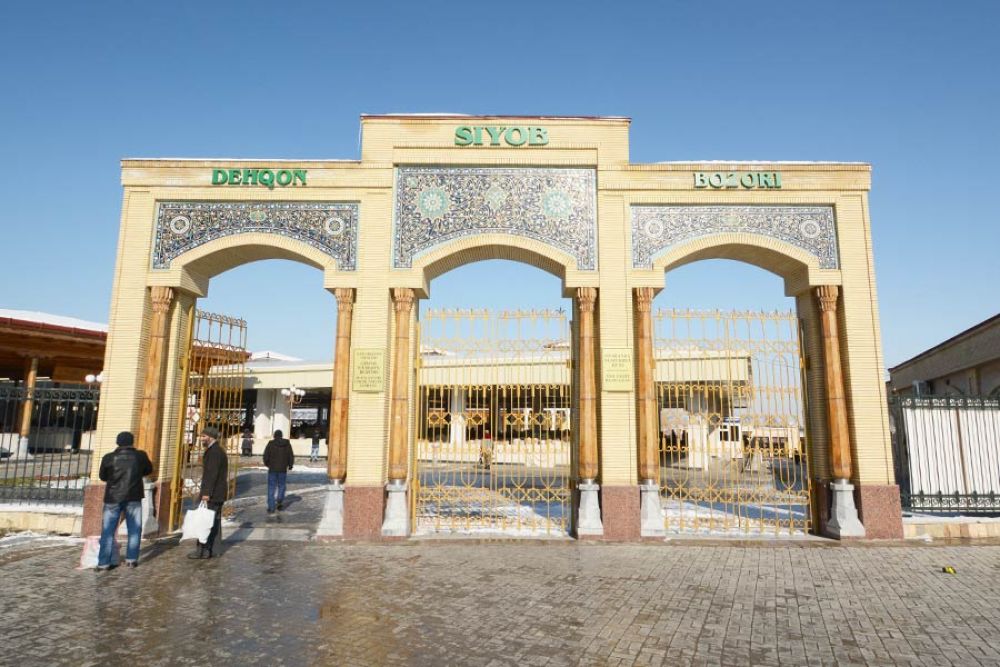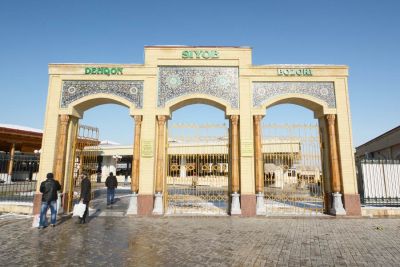

Registan Square is the centerpiece of the ancient city of Samarkand and arguably one of the most stunning architectural sites in Central Asia. This UNESCO World Heritage site is surrounded by three majestic madrasahs – Ulugh Beg, Sher-Dor, and Tilya-Kori, all of which boast ornate facades decorated with intricate blue tiles, carvings, and calligraphy. A visit to the Square takes you back hundreds of years and immerses you in the rich history of the Timurid dynasty. Inside the madrasahs, you can explore various historical exhibits and artisan workshops. The place also becomes magical at night, with beautifully lit buildings adding to the Square's ambiance. The site is not only a visual treat; it also offers insights into Samarkand's rich academic and cultural history.
Siab Bazaar is the largest and oldest bazaar in Samarkand, teeming with life and vibrant colors. Visiting this marketplace offers a sensory overload with the sounds of bartering, the sight of traditional Uzbek clothing, the aroma of fresh bread, and the taste test of countless spices and fruits. The bazaar serves as the city's social hub where people gather to not only trade but to socialize and share news. Here, you can purchase fresh produce, handicrafts, souvenirs, and traditional Uzbek food. Siab Bazaar is more than just a market; it's a cultural experience that allows travelers to witness and partake in the daily lives of the local Uzbek people. It's a place to learn about local customs, cuisine, and the Samarkand way of life.
Bibi-Khanym Mosque, once one of the Islamic world's largest and most magnificent mosques, was built by Timur in the 15th century as a grand architectural statement. Although severely damaged by time and earthquakes, restoration work has brought back much of its former glory. Visitors can walk through the mosque's enormous entrance portal and examine the intricate tile work up close. Inside, the mosque's vast courtyard and gigantic marble Quran stand to give a sense of its original grandeur. The mosque also tells the legend of Bibi-Khanym, Timur's wife, who supposedly built this mosque out of love for her husband, giving the place a romantic aura. Exploring this site is key to understanding the heights of craftsmanship and architecture during the Timurid era.
Shah-i-Zinda means 'The Living King' in Persian, and this stunning avenue of mausoleums, built from the 9th to the 14th centuries, holds an atmosphere of peace and reverence. As the final resting place of royalty and nobles, its tilework and ornamental detail are unlike any found in the world, with shades of blue that seem to echo the very sky above Uzbekistan. The walk along its pathway is a journey through time, revealing the story of Samarkand and its historical figures. With every step, visitors are swept away by the majesty and history of this sacred site. Shah-i-Zinda is more than a tourist attraction; it's a pilgrimage site for those who wish to pay their respects to the past and marvel at the artistry of bygone eras.
The Ulugh Beg Observatory, built in the 1420s by the astronomer-king Ulugh Beg, is an astounding reminder of the advanced astronomical knowledge that existed during the Timurid Empire. This observatory once housed a gigantic sextant, one of the largest in the world, which was used for mapping the stars and planets with stunning accuracy. Although little remains of the original structure, visitors can really appreciate Ulugh Beg's contribution to science. A reconstructed portion of the sextant and the underground museum exhibit the astronomical instruments and celestial charts developed during his time. A visit to this observatory not only showcases the scientific achievements of the medieval Islamic world but also presents a picture of a ruler who valued knowledge as much as conquest.
The Gur-e-Amir is the mausoleum of the great conqueror Tamerlane (also known as Timur) and is a masterpiece of medieval architecture with its fluted azure dome and majestic interior. The interiors are inlaid with gold and onyx, while the exterior is adorned with intricate geometric patterns that catch the light at different times of the day. As the resting place of Timur, two sons, and two grandsons (including Ulugh Beg), the mausoleum holds significant historical importance. The crypt itself is an evocative place where one can contemplate the legacy of one of history's most powerful rulers. Visitors come not just to gaze upon the resting place of a warlord but to admire the incredible craftsmanship that has endured the test of time.
The Afrasiyab Museum is situated on the site of ancient Samarkand's ruins, known as Afrasiyab, believed to have been one of the world's oldest inhabited cities. The museum showcases artifacts from excavations of the city, which dates back to the 6th century BCE. Items on display include ancient pottery, weapons, coins, and frescoes, which paint a picture of life in ancient Samarkand. The highlight is the large-scale ancient murals depicting the rich cultural and social activities of the Sogdian civilization. A tour through this museum is more than an educational outing; it's a connective experience where visitors truly feel the pulse of the ancient world that once throbbed in Central Asia.
Venture into the ancient craft of Samarkand paper-making at the Samarkand Paper Workshop. This unique activity allows you to witness the traditional process of silk paper-making, a method that dates back centuries and was once highly valued along the Silk Road. The workshop includes a comprehensive demonstration of the whole process, from boiling the mulberry bark to producing the final sheets of paper. At the end of the workshop, participants also have the opportunity to buy products made of this exquisite Samarkand paper, which can include books, albums, and various souvenirs. It's an excellent way to gain hands-on experience and bring home a piece of Samarkand's cultural heritage.
For those interested in culinary arts, a traditional Uzbek cooking class offers the perfect blend of culture and cuisine. The class begins with a trip to Siab Bazaar to source fresh ingredients, immersing participants in the local food culture. Then, under the guidance of a skilled chef, you will learn how to prepare classic Uzbek dishes such as plov (pilaf), manti (dumplings), and samsa (savory pastries). As you dive into the flavors and techniques, the cooking class becomes more than just about food; it becomes a doorway to understanding Uzbek family traditions and customs. The best part is sitting down at the end to enjoy the fruits of your labor—a scrumptious homemade meal.
For a night of cultural entertainment, the El Merosi Theatre in Samarkand is a wonderful venue to experience traditional Uzbek dance and music. The theatre's performances showcase the country's rich cultural tapestry, with artists dressed in vibrant, hand-embroidered costumes performing to folk music. The shows often narrate stories and legends of Uzbekistan's history and regions, giving you a glimpse into the nation's soul. Attending a performance at El Merosi Theatre is an excellent way to spend an evening, as the energy and passion of the performers are truly captivating, promising an unforgettable cultural enrichment.
